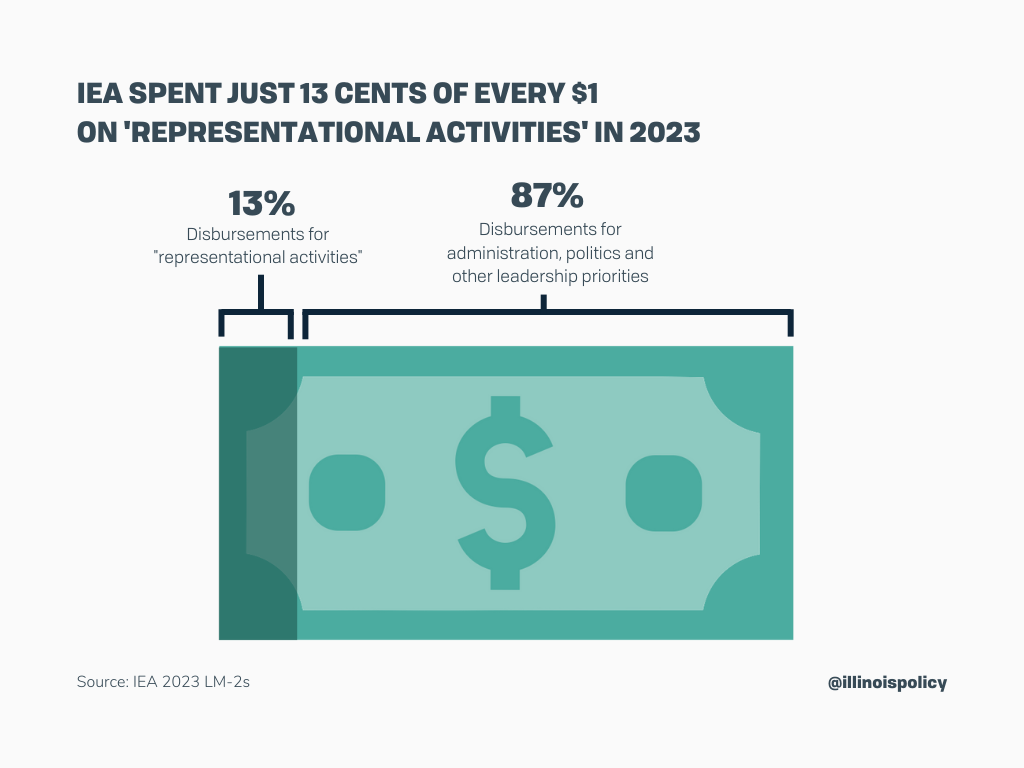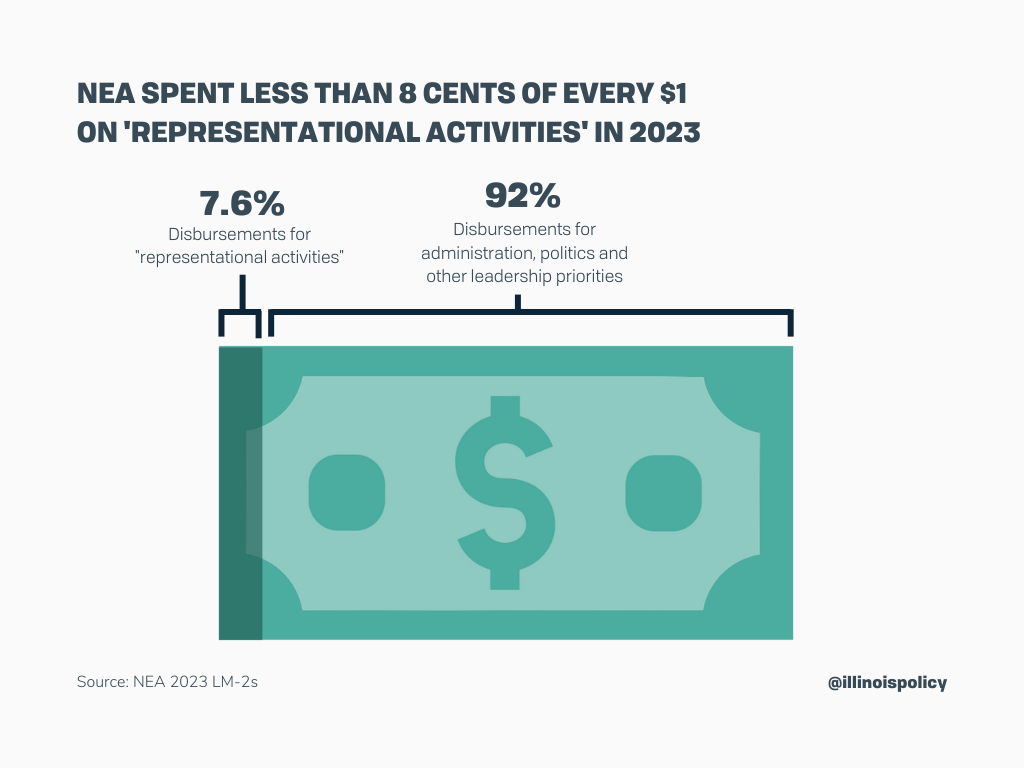Illinois Education Association puts union bosses’ agenda ahead of teachers’
Just 13% of IEA’s spending was on representing teachers in 2023. But the spending of its national affiliate – the National Education Association – was even worse, with less than 8% of its spending on representing teachers’ interests.
Teachers in Illinois can spend hundreds of dollars a year in union dues, but most of their money goes up the chain to the local union’s state and national affiliates.
Those affiliates use little of that money to represent teachers, according to their own accounting.
The largest teachers union in Illinois is the Illinois Education Association. Each year, IEA and its national affiliate, the National Education Association, file reports with the U.S. Department of Labor. Those reports show very little of their spending is on representing teachers, according to their own accounting. In fact, NEA spends more on politics than on representing teachers.
Below is what teachers should know about how IEA and NEA spend their membership dues. Concerned teachers have options. They can stop paying dues by opting out of union membership and still keep all the raises and other benefits their employers provide.
IEA did not prioritize teachers in 2023
IEA’s 2023 federal filing with the U.S. Department of Labor shows it spends little on “representational activities” but has increased its spending on politics. It pays more than 100 of its own employees six-figure salaries. At the same time, the union has pulled in more member dues while membership has gone down.
Just 13% of IEA’s spending in 2023 was on representing teachers
IEA’s most recent report shows it spent little last year on “representational activities,” which the U.S. Department of Labor defines as including the negotiation of a collective bargaining agreement and the administration and enforcement of the resulting contract.
IEA spent a total of $91.3 million in 2023. Of that, just $11.9 million was on representing teachers. That’s just 13% of its total spending.
The rest was spent on politics, administration and other union leadership priorities.

This continues a downward trend. IEA spent 14.6% on representation in 2021 and 14.2% in 2022.
To put this in perspective, the Better Business Bureau’s Wise Giving Alliance states at least 65% of a nonprofit’s total expenses should be used for program activities.
While the Wise Giving Alliance evaluates spending by charities, it stands to reason IEA’s spending of just 13% on representation – the purpose of a union – should be a cause for concern among members.
IEA spent more than $1.8M on politics and lobbying in 2023
While IEA was busy stripping money away from representing teachers, it spent more than $1.8 million on “political activities and lobbying” in 2023. Of that, only $80,000 was itemized in its federal report, noted as going to the Center for Tax and Budget Accountability.
That means more than $1.7 million of its political spending is unspecified, and Illinois educators have no way of knowing what political causes or candidates got that money.
It is the third-highest amount IEA has spent on politics since 2005, when it started filing the federal reports.
IEA membership has dropped for the third consecutive year – yet it collected more in dues
IEA’s membership peaked in 2020, reporting a record 137,442 members – the highest number reported in its federal filings.
Since then, the union has been in a multi-year decline, dropping 3% since its height. The union reported 133,256 members in 2023.
But while there are fewer members within IEA, the union is collecting more in dues. The union reported an increased amount of incoming member dues in 2023.
The union pays more than 100 of its employees six-figure salaries
IEA’s own officers and other employees are well paid. More than one-third of its employees earn over $100,000. In fact, the top 13 earners make over $200,000, with 80 making $150,000 or more.
Notably, the average teacher in Illinois makes less than $74,000, according to the Illinois State Board of Education. It appears IEA is taking teacher union dues to prop up its own expensive employees while failing to spend more than 13 cents of every dollar to actually represent those teachers.
National Education Association prioritizes politics over teachers
The National Education Association spent more than a half billion dollars in 2023. Yet not even one-tenth of its spending was on representing teachers – what should be its main focus. Instead, it spent more on politics than representation and paid nearly 450 of its own officers and employees six-figure incomes.
It’s no wonder its membership is dropping nationally.
Less than 8% of NEA’s spending in 2023 was on representing teachers
NEA’s 2023 federal filing shows a stunning lack of respect for educators. It spent $520.2 million in total, yet just $39.3 million was on “representational activities.”
That means not even 8% of its spending was on representing teachers, which should be its core purpose. The rest was spent on politics, administration and other union leadership priorities.

This is in stark contrast to the 65% the Better Business Bureau’s Wise Giving Alliance says should be spent on an organization’s main programming.
NEA spent 28% more on politics than on representation in 2023
NEA’s abysmal spending on teachers looks even worse when compared to its spending on politics. In 2023, it spent $50.1 million on “political activities and lobbying” – 28% more than it did on representing teachers.
The top recipient was NEA Advocacy Fund, its own Super PAC, which contributes to political campaigns. In the 2023-2024 election cycle, NEA Advocacy Fund funneled over $592,000 to Democratic candidates and nothing to Republican candidates.
But that’s not all. NEA spent an additional $126.4 million on “contributions, gifts, and grants,” many of which were also political in nature. For example, NEA contributed $3.45 million to For our Future Action Fund, which bills itself as building “progressive power through voter engagement.”
NEA is in a multi-year membership decline
NEA’s membership peaked in 2009 with 3,321,881 members across the nation. But the union’s membership has been in decline since 2019.
The union reported just 2.86 million members nationwide in 2023, a 14% drop since its peak in 2009.
Nearly 450 NEA employees earn six-figure salaries
While members may not be seeing the benefits of sending hundreds of dollars a year up the chain to the national affiliate, NEA’s own officers and employees sure do. At least 448 of its own employees make over $100,000. More than 70 make over $200,000, with President Rebecca Pringle raking in nearly $500,000.
As with other aspects of NEA’s disbursements, its spending on hundreds of its own officers and employees demonstrates its lack of respect for teachers. The average teacher in Illinois makes less than $74,000, yet teachers send hundreds of dollars in dues to IEA and NEA each year.
Teachers have other options
Illinois educators who want more control over their dues have options:
- Teachers can get liability insurance and legal protection elsewhere. Educators can join other associations, such as the Association of American Educators. AAE, which has more than 30,000 members across the country, provides liability insurance and legal protection to public school employees – typically at a fraction of the cost of union membership.
- Teachers can opt out of union membership and keep all employer-provided benefits. By opting out of union membership, a teacher stops paying dues to the union yet retains all benefits that are provided in the collective bargaining agreement with the school district.
Opting out doesn’t mean educators don’t support their local bargaining unit. In fact, educators are free to send voluntary donations to their local bargaining units without being members – thereby helping to ensure their support stays local.
For more information, visit LeaveIEA.com.
